In a series of 6 articles published in Dog World over a number of years, I have described the introduction of a dominantly inherited bobtail gene into the Boxer to produce an undocked dog with a naturally short tail. This was achieved by repeated backcrossing to Boxer after an initial cross to a bobtail Pembroke Welsh Corgi. In the course of this work, a molecular genetic study was also conducted and this identified the bobtail gene itself at the DNA level. Essential to the identification was a co-occurrence of the bobtail effect with the DNA change identified. There was however a problem.
THE PROBLEM
As described in a postscript to the last article (Part 6) one apparent exception to the co-occurrence of the tail effect and DNA change was found. A bitch that was thought to have a bobtail did not in fact carry the changed DNA thought to represent the bobtail gene mutation. On re-examination, however, this abnormal tail was found to have a kinked bony structure unlike the bobtail with its typical "fatty" distal pad and profusely hair-covered filament at the tip. Instead, it closely resembled the "screw tails" that occur occasionally in perhaps all long-tailed breeds. Therefore, was this abnormal tail attributable to a chance, non-inherited screw tail effect rather than to the bobtail gene? In so far as the answer was essential to correct identification of the gene, it was necessary to resolve this issue. This could be done by test-mating the bitch to determine if the tail effect was inherited or not. If it was not inherited, the bobtail gene was not
involved and the bitch would not be expected to have the bobtail gene.
This article describes the test-mating and the results obtained. But in constructing the test it seemed worthwhile asking a further question of more general breeder interest. Would any Corgi-type characteristics (short legs, long coat etc) reappear if one additionally inbred on Corgi?
THE APPROACH
The screw tailed bitch was from the fourth generation of crossing and looked typically Boxer (Fig 1).
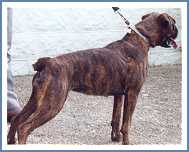 |
|
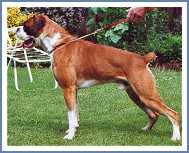 |
| Fig. 1 The "screw tail" bitch; fourth generation from Corgi. |
|
Fig. 2 docked dog used for stud, also fourth generation. |
To test if she would transmit the tail effect to her progeny, she was mated to a normal tailed dog, And, to answer the question on the possibility of Corgi characteristics reappearing in her progeny if one "doubled up" on Corgi, she was mated to dog that, like her, was only four generations removed from Corgi. He too looked a fairly good Boxer (Fig 2).
THE ANSWERS
1. Was the abnormal tail inherited?
The abnormal tailed bitch produced seven puppies and all had perfectly normal long tails (Fig. 3).
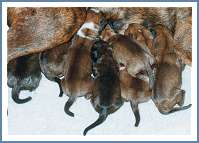 |
|
If the tail abnormality was due to the bobtail gene, half the pups on average should have had some form of bobtail. However, based on the 50:50 expectation, the chances of no abnormal tails pups being produced among seven born with is less than one in a hundred. It may therefore be concluded that it is extremely unlikely that the exceptional bitch carried the bob-tail gene and, accordingly, the molecular identification of the bobtail gene is validated. The abnormal tail can best be ascribed to one of those rare non-inherited developmental anomalies that are found when one breeds animals. Several examples of this type of tail have in fact been noted in Boxers over recent years. |
Fig. 3 Litter from screw tail bitch; all long tails. |
|
2. Could Corgi characteristics reappear on inbreeding?
All seven pups looked typically Boxer at birth but health problems limited the study. The bitch required a caesarian, (as had her Boxer mother before her), the stitching broke down, and infection set in. This necessitated her return to the vets for re-anaesthesia, re-stitching and antibiotic treatment. The bitch was quite ill, she lost her milk for a few days and, despite all efforts, three of the seven pups faded.
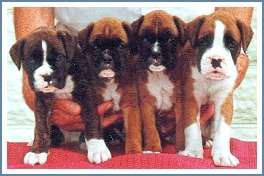
Fig. 4: Four surviving puppies from the "double" Corgi litter at 6 -8 weeks
A mere four pups is not very informative but, at about 6 weeks, all looked typical Boxer puppies (Fig 4 - 6).
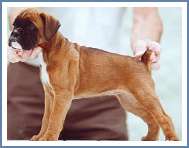 |
|
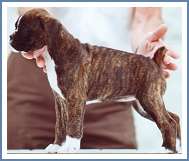 |
Fig. 5 |
|
Fig. 6 |
All were short backed, had decent heads with obvious Boxer chins. Certainly none showed any trace of the short legs and longer coat type of the Corgi in complete accord with genetic expectation based on the established inheritance of these characteristics.
WHERE NOW?
The investigative parts of this bobtail project are now complete, although bobtail x bobtail test-matings will be conducted in some later generation/s. The key question that remains is breeder attitude to the bobtail as an alternative to docking in the event of a complete docking ban. For the present, there is limited interest in the UK although one major breeder is now highly enthusiastic about bobtail Boxers and intends to introduce the gene into her kennel. A few smaller kennels are also interested as a means of reducing the need for docking. The main interest in the bobtail, however, is developing abroad - in countries where docking has been banned.
The bobtail male, Steynmere Hot Shot (Fig 8), that I sent to Norway has created much interest there.
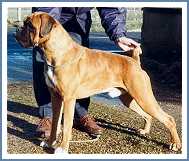 |
|
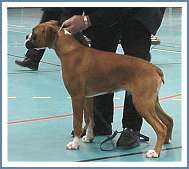 |
Fig. 8 Steynmere Hot Shot, bob-tail dog now in Norway. |
|
Fig. 9 The first Hot Shot bob-tail son to be shown in Norway. |
Indeed, an article centred around the dog has recently been published in a major Norwegian dog magazine, Hundesport, and has even aroused interest in the bobtail among breeders of other traditionally docked breeds.
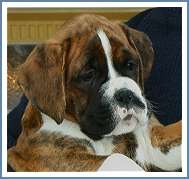 |
|
Hot Shot is being used at stud in Finland, Sweden, and Holland, as well as in Norway, and breeders have been impressed by his first pup (Fig 9).
who caught attention recently with a remarkable fourth place in an entry of thirteen youngsters - under a German specialist judge.
|
Fig. 9 The latest Hot Shot pup |
|
Meanwhile an impressive Hot Shot daughter, Steynmere Corona (Fig 12), with possibly two other bitches (one by Santonoaks Red Hot Prospect and one by Barbarossa Matador Magic) and also her brother, Steynmere Total Eclipse (Fig 13) will keep the bobtail flag flying here in the UK.
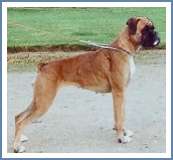 |
|
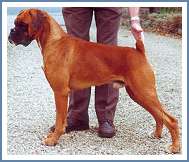 |
Fig. 12 Steynmere Corona, the key fifth generation bitch (by Hot Shot) to carry on the line in the UK. |
|
Fig. 13 Steynmere Total Eclipse, show winning brother of Corona. |


